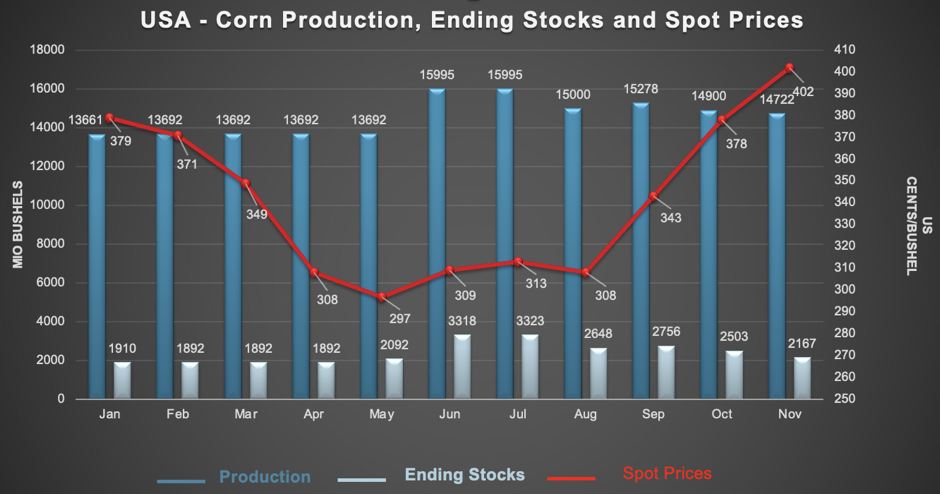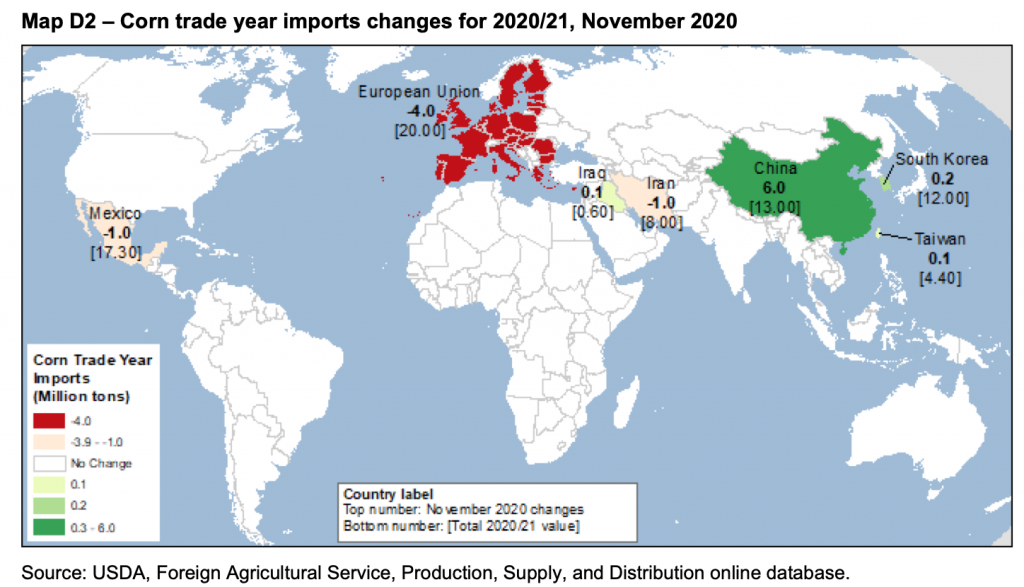PRICE
From October to November, the corn spot price has risen to about $4 a bushel, an increase of about 40 cents from last month’s forecast. This is a result of the decrease of production outlook and the increase in the US exports (increased foreign demand and decreased foreign production).

Source : Bloomberg
GLOBAL DEMAND INCREASES AND SUPPLIES REDUCED

U.S. maize production is expected to be 14’722 million bushels, based on lower national maize yields, a 178 million bushel decrease from the previous month due to a smaller harvest and lower beginning stocks.
Ukrainian maize production and exports have both collapsed due to hot and dry conditions, establishing a global supply gap for exports giving export opportunities for U.S. corn. Ukraine being the 4th largest exporter of corn. Lower production in Ukraine, the EU, Russia and Moldova more than compensating the increases in South Africa and Laos.

EU maize imports are expected to decrease by 4.0 million tonnes this month to 20.0 million tonnes. This is mainly due to a decrease in corn feed use. Indeed, the growth of the EU livestock sector is slow and the price of corn is high. The reduction in the corn feeding is expected to be partially compensated by the region’s use of more wheat and other coarse grains.
In Mexico, the use and imports of maize feed also decreased, down 1.0 million tons. This decrease is motivated by decreased demand for feed from its pork and beef sectors, where the recovery from the downturn in Covid-19 appears to be slower than expected.
The low speed of imports of Iranian maize (from Brazil and Ukraine) has led to a decrease of 1.0 million tons this month.
However, Chinese imports of corn have increased significantly to meet the growing demand for feed because its livestock inventories and production of meat increased.
ENDING STOCKS
Ending stocks are forecast at 2’167 million bushels, down 336 million bushels from the previous month. Declining global supply and increased U.S. exports more than compensating reductions in exports elsewhere are driving down ending stock.
FORWARD CURVE

Source : https://www.cmegroup.com/trading/agricultural/grain-and-oilseed/corn_quotes_settlements_futures.html
We can see that the forward curve has almost the same shape but the prices agreed on the 24th of November are higher than the price agreed on the 31th of October. The prices are higher because production decreased and export increased.
It is a normal curve (it is well supplied) from December to July (the message is to store) and goes into an inverse curve (the demand is hot) from July to December (the message is to deliver). This is due to seasonality.
RECOMMENDATION
As shown, production decreased this month and there is an increase in the demand from China. We can also add that the beginning stocks were lower as compared to the previous year.
Furthermore, the news of the vaccine for COVID-19 and the end of lockdown in some countries will reassure the economics agents and push them to be bullish.
We also find that the US plans to extend crop acre for next year, that will compensate for the drop in supply this year.
Therefore, we recommend going long.
Léo Millet, Maike Da Silva, Patrice Correia Cardoso & Cassandra Kirchhoff
SOURCES
Bloomberg.com, [sans date]. Bloomberg.com [en ligne]. [Consulté le 23 novembre 2020]. Disponible à l’adresse : https://www.bloomberg.com/europe
Corn Futures Settlements – CME Group, [sans date]. [en ligne]. [Consulté le 23 novembre 2020]. Disponible à l’adresse : https://www.cmegroup.com/content/cmegroup/en/trading/agricultural/grain-and-oilseed/corn_quotes_settlements_futures.html
grain-corn-coarsegrains.pdf, [sans date]. [en ligne]. [Consulté le 23 novembre 2020]. Disponible à l’adresse : https://apps.fas.usda.gov/psdonline/circulars/grain-corn-coarsegrains.pdf
McConnell et Olson – 2020 – U.S. Corn Production Projections Reduced for 2020.pdf, [sans date]. [en ligne]. [Consulté le 24 novembre 2020]. Disponible à l’adresse :https://downloads.usda.library.cornell.edu/usda-esmis/files/44558d29f/rb68z388r/wm118f39n/FDS-20k.pdf
USDA ERS – Market Outlook, [sans date]. [en ligne]. [Consulté le 25 novembre 2020]. Disponible à l’adresse : https://www.ers.usda.gov/topics/crops/corn-and-other-feedgrains/market-outlook/
wasde1020.pdf, [sans date]. [en ligne]. [Consulté le 25 novembre 2020]. Disponible à l’adresse :https://www.usda.gov/oce/commodity/wasde/wasde1020.pdf

